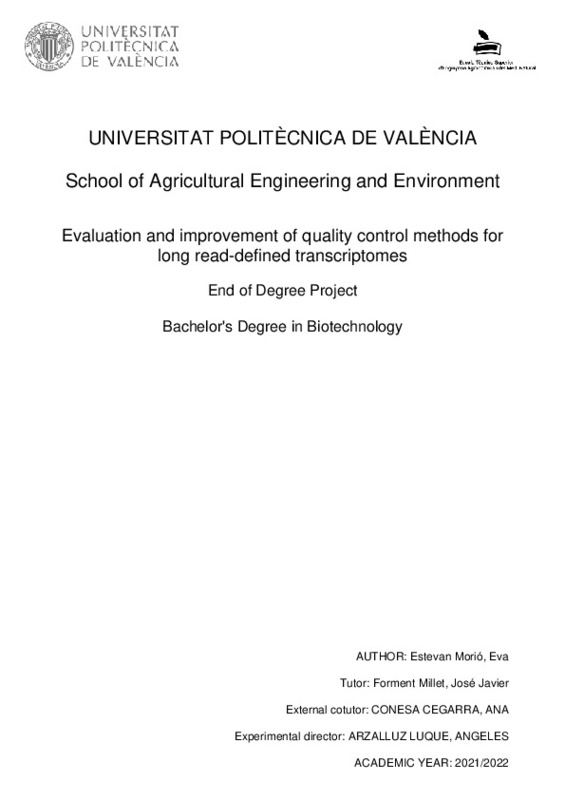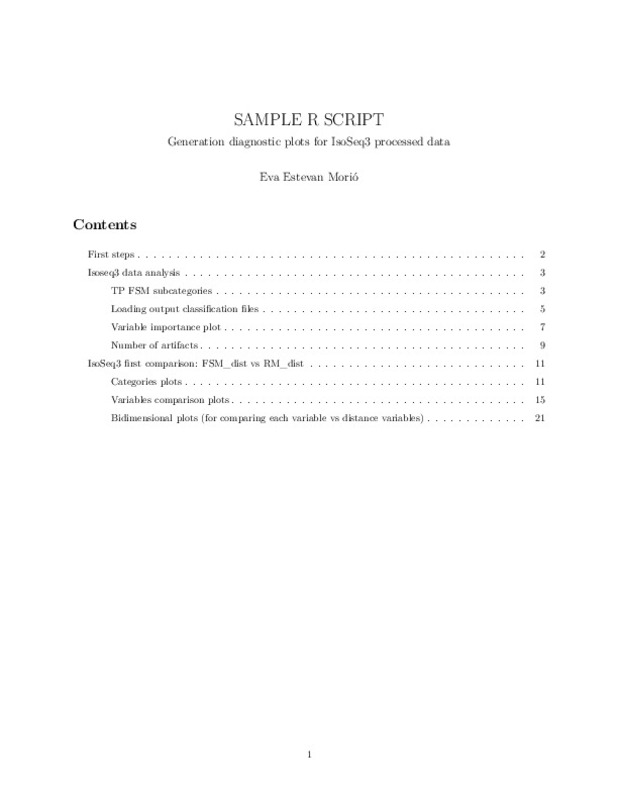JavaScript is disabled for your browser. Some features of this site may not work without it.
Buscar en RiuNet
Listar
Mi cuenta
Estadísticas
Ayuda RiuNet
Admin. UPV
Evaluation and improvement of quality control methods for long read-defined transcriptomes
Mostrar el registro sencillo del ítem
Ficheros en el ítem
| dc.contributor.advisor | Forment Millet, José Javier
|
es_ES |
| dc.contributor.advisor | Conesa Cegarra, Ana
|
es_ES |
| dc.contributor.advisor | Arzalluz Luque, Ángeles
|
es_ES |
| dc.contributor.author | Estevan Morió, Eva
|
es_ES |
| dc.date.accessioned | 2022-09-06T13:54:02Z | |
| dc.date.available | 2022-09-06T13:54:02Z | |
| dc.date.created | 2022-07-15 | |
| dc.date.issued | 2022-09-06 | es_ES |
| dc.identifier.uri | http://hdl.handle.net/10251/185371 | |
| dc.description.abstract | [ES] Las tecnologías de secuenciación de alto rendimiento de transcriptomas mediante lecturas largas han facilitado el descubrimiento de nuevos transcritos. No obstante, dichas tecnologías tienen una tasa de error muy superior a las basadas en lecturas cortas, por lo que requieren herramientas que permitan caracterizar estas variantes noveles y filtrar las que son falsos positivos. De esta necesidad nace SQANTI3 (Structural and Quality Annotation of Novel Transcript Isoforms), un software para el análisis de transcriptomas construidos a partir de lecturas largas. SQANTI3 toma un conjunto de datos de transcritos, junto con la anotación del genoma y, si están disponibles, otros datos ortogonales (expresión, validación de los extremos 3¿ y 5¿, etc.), para devolver un transcriptoma corregido. Asimismo, la herramienta proporciona un amplio conjunto de descriptores de las isoformas y sus sitios de splicing, que se analizan más a fondo en varias gráficas de diagnóstico. SQANTI3 incorpora un clasificador basado en inteligencia artificial (MLfilter) que discrimina, de manera automatizada, los transcritos que pueden considerarse verdaderas isoformas de los potenciales artefactos. Dicho filtro se basa en un algoritmo de 'random forest', que aporta múltiples ventajas al análisis transcriptómico, entre ellas evita el uso de umbrales establecidos manualmente para cada variable descriptora. Sin embargo, como todo modelo de machine learning, se trata de una caja negra, es decir, se desconoce lo que pasa entre la entrada de datos y la salida de una predicción. Comparando distintas combinaciones de parámetros de entrenamiento del MLfilter, hemos caracterizado su funcionamiento y hemos establecido una serie de guías para optimizar la definición de los datos de entrenamiento en función del tipo de datos de partida. Concretamente, se ha evaluado la adecuación del set de transcritos tomados como verdaderos positivos por el clasificador, así como las variables más relevantes para obtener una buena clasificación artefacto-isoforma. Además, hemos detectado errores evitables, como el ¿overfitting¿ o sobreajuste. Todo esto, contribuirá a unas mejores prácticas por parte de la gran comunidad de usuarios que emplean SQANTI3 para refinar sus transcriptomas y abrirá la puerta a futuras investigaciones para mejorar el MLfilter. | es_ES |
| dc.description.abstract | [EN] High-throughput long-read transcriptome sequencing technologies have facilitated the discovery of novel transcripts. Nevertheless, these technologies have a much higher error rate than those based on short reads and therefore specific tools are required to characterise these novel variants and filter out false positives. SQANTI3 (Structural and Quality Annotation of Novel Transcript Isoforms), a software for analysing long read-based transcriptomes, was born out of this need. SQANTI3 takes a transcriptome, together with genome annotation and, if available, other orthogonal data (expression, validation of the 3' and 5' ends, etc.) to return a corrected transcriptome. The tool also provides a wide set of descriptors of the isoforms and their splice junctions, which are further analysed in several diagnostic plots. SQANTI3 includes an artificial intelligence-based classifier (MLfilter) that automatically discriminates transcripts that can be considered true isoforms from potential artifacts. This filter is based on a random forest algorithm, which brings multiple advantages to transcriptomic analysis, such as avoiding the use of manually set thresholds for each descriptor variable. However, like any machine learning model, it is a black box meaning that what happens between the input data and the predicted output is unknown. By comparing different parameter set ups, we have characterised the MLfilter¿s performance for two transcriptome datasets and established guidelines to optimise the choice of training data according to the input data type. Specifically, we have evaluated the adequacy of the set of transcripts taken as true positives by the classifier, as well as the most relevant variables to obtain a good artifact-isoform classification. We have also detected avoidable biases such as overfitting. Ultimately, this work will help define best practices for the large community of researchers who use SQANTI3 to refine their transcriptomes and will allow further research to improve the MLfilter. | es_ES |
| dc.format.extent | 76 | es_ES |
| dc.language | Inglés | es_ES |
| dc.publisher | Universitat Politècnica de València | es_ES |
| dc.rights | Reconocimiento - No comercial - Compartir igual (by-nc-sa) | es_ES |
| dc.subject | Transcriptómica | es_ES |
| dc.subject | Lecturas largas | es_ES |
| dc.subject | Isoformas | es_ES |
| dc.subject | Transcriptomics | es_ES |
| dc.subject | Long-reads | es_ES |
| dc.subject | Isoforms | es_ES |
| dc.subject.classification | BIOQUIMICA Y BIOLOGIA MOLECULAR | es_ES |
| dc.subject.other | Grado en Biotecnología-Grau en Biotecnologia | es_ES |
| dc.title | Evaluation and improvement of quality control methods for long read-defined transcriptomes | es_ES |
| dc.title.alternative | Evaluación y mejora de métodos de control de calidad de transcriptomas elaborados a partir de lecturas largas | es_ES |
| dc.title.alternative | Evaluació i millora de mètodes de control de qualitat de transcriptomes elaborats a partir de lectures llargues | es_ES |
| dc.type | Proyecto/Trabajo fin de carrera/grado | es_ES |
| dc.rights.accessRights | Abierto | es_ES |
| dc.contributor.affiliation | Universitat Politècnica de València. Departamento de Biotecnología - Departament de Biotecnologia | es_ES |
| dc.contributor.affiliation | Universitat Politècnica de València. Escuela Técnica Superior de Ingeniería Agronómica y del Medio Natural - Escola Tècnica Superior d'Enginyeria Agronòmica i del Medi Natural | es_ES |
| dc.description.bibliographicCitation | Estevan Morió, E. (2022). Evaluation and improvement of quality control methods for long read-defined transcriptomes. Universitat Politècnica de València. http://hdl.handle.net/10251/185371 | es_ES |
| dc.description.accrualMethod | TFGM | es_ES |
| dc.relation.pasarela | TFGM\149663 | es_ES |
Este ítem aparece en la(s) siguiente(s) colección(ones)
-
ETSIAMN - Trabajos académicos [3284]
Escuela Técnica Superior de Ingeniería Agronómica y del Medio Natural







